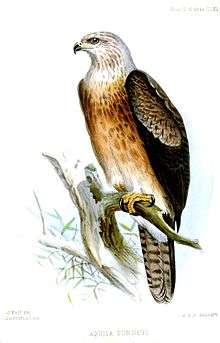Gurney's eagle
| Gurney's eagle | |
|---|---|
 | |
| Scientific classification | |
| Kingdom: | Animalia |
| Phylum: | Chordata |
| Class: | Aves |
| Order: | Accipitriformes |
| Family: | Accipitridae |
| Genus: | Aquila |
| Species: | A. gurneyi |
| Binomial name | |
| Aquila gurneyi Gray, 1860 | |
Gurney's eagle (Aquila gurneyi) is a large eagle in the family Accipitridae. It is found from the Moluccas to Irian Jaya and most of New Guinea.
The common name and Latin binomial commemorate the British banker and amateur ornithologist John Henry Gurney (1819–1890).[2]
Description
This eagle is a fairly large species, though mid-sized as a member of the Aquila genus. It is mainly dark brown to black, with paler undersides to its flight feathers and a rounded tail. Its body length is 74–86 cm (29–34 in) with a wingspan of between 1.65 and 1.9 m (5.4 and 6.2 ft). One immature bird reportedly weighed 3.06 kg (6.7 lb).[3] Females are larger than males. Its wings are held level when gliding. It feeds on mammals (such as cuscuses), reptiles, fish, and birds.
Range and habitat
Gurney's eagle is found from the Moluccas to Irian Jaya and most of New Guinea, from sea level to 1500 meters above sea level. It has been recorded from Saibai and Boigu islands in north-western Torres Strait, thus putting it on the Australian bird list. it inhabits a wide range of habitats from sea level to the snow line.
Conservation
Gurney's eagle occurs at low population densities and is likely to be declining slowly through habitat loss and degradation. It is considered to be Near Threatened and is listed on CITES Appendix II.
References
- ↑ BirdLife International (2012). "Aquila gurneyi". IUCN Red List of Threatened Species. Version 2013.2. International Union for Conservation of Nature. Retrieved 26 November 2013.
- ↑ Beolens, Bo; Watkins, Michael (2003). Whose Bird? Men and Women Commemorated in the Common Names of Birds. London: Christopher Helm. p. 153.
- ↑ "Raptors of the World" by Ferguson-Lees, Christie, Franklin, Mead & Burton. Houghton Mifflin (2001), ISBN 0-618-12762-3
- BirdLife International (2006). Species factsheet: Aquila gurneyi. Downloaded from http://www.birdlife.org on 9/12/2006
- Coates, B.J. (1985). The Birds of Papua New Guinea, Vol. 1, Non-Passerines. Dove: Alderley, Queensland. ISBN 0-9590257-0-7
- Morcombe, Michael (2000). Field Guide to Australian Birds. Steve Parish Publishing: Queensland. ISBN 1-876282-10-X
